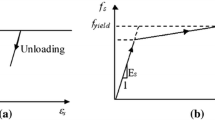Abstract
A nonlinear theoretical model is developed in this paper for the long-term analysis of continuous reinforced concrete beams. The model accounts for creep, cracking, nonlinear behaviour in compression, shrinkage, aging, yielding of the reinforcement. The constitutive relations follow the modified principle of superposition, which are presented in the form of nonlinear rheological generalized Maxwell models with strain and time dependent springs and dashpots that account for material nonlinearity and aging of the concrete. The governing equations are presented in an incremental form, and are solved through a step-by-step algorithm in time along with the numerical shooting method for the solution along the beam. An iterative procedure is implemented at each time step for the determination of the rigidities and the creep strains. The capabilities of the model are demonstrated through numerical examples. The results show that creep and shrinkage have various influences on the structural response, and they may decrease the load carrying capacity and the factor of safety of continuous reinforced concrete beams with time.











Similar content being viewed by others
References
Bacinskas, D., Kaklauskas, G., Gribniak, V., Sung, W.P., Shih, M.H.: Layer model for long-term deflection analysis of cracked reinforced concrete bending members. Mech. Time-Depend. Mater. 16(2), 117–127 (2012)
Bakoss, S.L., Gilbert, R.I., Faulkes, K.A., Pilmano, V.A.: Long-term deflections of reinforced concrete beams. Mag. Concr. Res. 34(121), 203–212 (1982)
Balevičius, R., Dulinskas, E.: On the prediction of non-linear creep strains. J. Civ. Eng. Manag. 16(3), 382–386 (2010)
Bažant, Z.P., Asghari, A.A.: Constitutive law for nonlinear creep of concrete. J. Eng. Mech. Div. 103(1), 113–124 (1977)
Bažant, Z.P., Kim, S.S.: Nonlinear creep of concrete—adaptation and flow. J. Eng. Mech. Div. 105(3), 429–446 (1979)
Bažant, Z.P., Oh, B.H.: Deformation of progressively cracking reinforced concrete beams. ACI J. 81(3), 268–278 (1984)
Bažant, Z.P., Prasannan, S.: Solidification theory for concrete creep: I. Formulation. J. Eng. Mech. 115(8), 1691–1703 (1989)
Bažant, Z.P., Wu, S.T.: Rate-type creep law of aging concrete based on Maxwell chain. Mater. Struct. 7(1), 45–60 (1974)
Carol, I., Bažant, Z.P.: Viscoelasticity with aging caused by solidification of nonaging constituent. J. Eng. Mech. 119(11), 2252–2269 (1993)
Carol, I., Murcia, J.: A model for the non-linear time-dependent behaviour of concrete in compression based on a Maxwell chain with exponential algorithm. Mater. Struct. 22(3), 176–184 (1989)
CEB-FIP: Structural concrete. Textbook on behaviour, design and performance. Updated knowledge of the CEB/FIP Model Code 1990. Comite Euro-International du Beton/Federation International de la Precontrainte, Fib-bulletin no. 1, Lausanne, Switzerland (1999)
Cervenka, V., Jendele, L., Cervenka, J.: ATENA Program Documentation, Part 1: Theory. Cervenka Consulting, Prague (2012)
Espion, B.: Long term sustained loading test of reinforced concrete beams. Technical report Brussels, Belgium (1988)
Fernández Ruiz, M., Muttoni, A., Gambarova, P.G.: Relationship between nonlinear creep and cracking of concrete under uniaxial compression. J. Adv. Concr. Technol. 5(3), 383–393 (2007)
Findley, W.N., Lai, J.S., Onran, K.: Creep and Relaxation of Nonlinear Viscoelastic Materials (with an Introduction to Linear Viscoelasticity). North-Holland, Amsterdam (1976)
Gilbert, R.I., Ranzi, G.: Time-Dependent Behaviour of Concrete Structures. Spon, London (2011)
Hamed, E.: Nonlinear creep response of reinforced concrete beams. J. Mech. Mater. Struct. 7(5), 435–460 (2012)
Leaderman, H.: Elastic and Creep Properties of Filamentous Materials and Other High Polymers. The Textile foundation, Washington (1943)
Li, Z., Qian, J.: Creep damage analysis and its application to nonlinear creep of reinforced concrete beam. Eng. Fract. Mech. 34(4), 851–860 (1989)
Mazzotti, C., Savoia, M.: Nonlinear creep damage model for concrete under uniaxial compression. J. Eng. Mech. 129(9), 1065–1075 (2003)
Neville, A.M., Dilger, W.H.: Creep of Concrete: Plain, Reinforced, and Prestressed. North-Holland, Amsterdam (1970)
Papa, E., Taliercio, A., Gobbi, E.: Triaxial creep behaviour of plain concrete at high stresses: a survey of theoretical models. Mater. Struct. 31(7), 487–493 (1998)
Pipkin, A.C., Rogers, T.G.: A non-linear integral representation for viscoelastic behaviour. J. Mech. Phys. Solids 16(1), 59–72 (1968)
Rots, J.G., de Borst, R.: Analysis of mixed-mode fracture in concrete. J. Eng. Mech. 113(11), 1739–1758 (1987)
Rusch, H.: Researches toward a general flexural theory for structural concrete. ACI J. Proc. 57, 1–28 (1960)
Santhikumar, S., Karihaloo, B.L., Reid, G.: A model for ageing visco-elastic tension softening material. Mech. Cohes.-Frict. Mater. 3, 27–39 (1998)
Smadi, M.M., Slate, F.O., Nilson, A.H.: High-, medium-, and low-strength concretes subject to sustained overloads-strains, strengths, and failure mechanisms. ACI J. Proc. 82, 657–664 (1985)
Stoer, J., Bulirsch, R.: Introduction to Numerical Analysis. Springer, Berlin (2002)
Thornton, G.M., Oliynyk, A., Frank, C.B., Shrive, N.G.: Ligament creep cannot be predicted from stress relaxation at low stress: a biomechanical study of the rabbit medial collateral ligament. J. Orthop. Res. 15(5), 652–656 (1997)
Washa, G.W., Fluck, P.G.: Plastic flow (creep*) of reinforced concrete continuous beams. ACI J. Proc. 52, 549–561 (1956)
Zhou, F.P.: Numerical modelling of creep crack growth and fracture in concrete. In: Localized Damage III: Computer-Aided Assessment and Control. Transaction on Engineering Sciences, vol. 6, pp. 141–148 (1994)
Author information
Authors and Affiliations
Corresponding author
Rights and permissions
About this article
Cite this article
Hamed, E. Modelling of creep in continuous RC beams under high levels of sustained loading. Mech Time-Depend Mater 18, 589–609 (2014). https://doi.org/10.1007/s11043-014-9243-7
Received:
Accepted:
Published:
Issue Date:
DOI: https://doi.org/10.1007/s11043-014-9243-7




